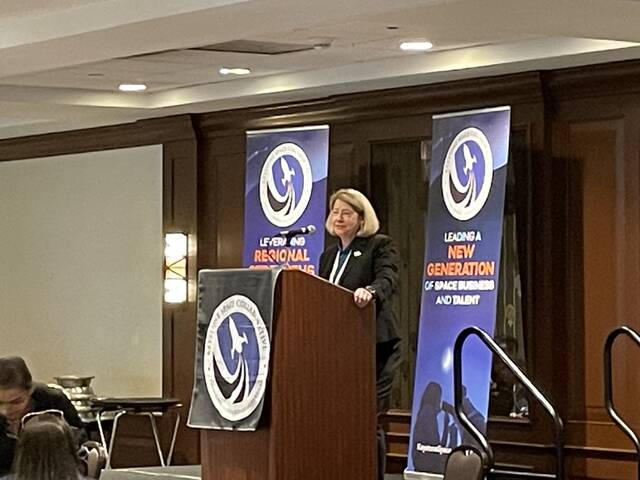Pittsburgh-based Astrobotic partners with Jeff Bezos company to build a lunar lander
The lunar road back to the moon “lies right here, through the Keystone State,” NASA Deputy Administrator Pam Melroy said during a visit to Pittsburgh on Friday.
Sixty-three Pennsylvania suppliers contributed to NASA’s Artemis mission, which aims to return humans to the moon and use that as a launching point to Mars and beyond. North Side-based aerospace and robotics company Astrobotic is among the companies working on a project to develop a lunar lander.
In May, NASA awarded a $3.4 billion contract to Blue Origin, the company created by Amazon.com founder Jeff Bezos, to lead a team to develop the lander. The goal is to transport astronauts to the lunar surface as early as 2029. Astrobotic is part of that team, along with Lockheed Martin, Draper, Boeing and Honeybee Robotics.
Speaking at the 2023 Keystone Space Collaborative conference in Station Square on Friday, Melroy, a retired U.S. Air Force officer and astronaut, said she was inspired by the first moon landings. She wants these next missions to create a similar kind of awe.
“I was a part of the Apollo generation,” said Melroy, who has logged more than 38 days (924 hours) in space. “I watched the moon landings and I said, ‘I want to go do that.’ It inspired a whole generation of scientists, engineers, astronauts and aviators. We’re on the cusp of the Artemis generation, and we will be seeing that next tidal wave coming at us.”
Astrobotic will provide the cargo accommodation system, which, in concert with Blue Origin’s lander, “allows for safe landing and operation of mission critical, very large cargo like astronaut habitats or pressurized rovers,” the company said. Astrobotic will also support the development of lunar landing sensors.
Melroy served as pilot on two flights and was the mission commander on another. All three of her missions were assembly missions to build the International Space Station.
“When we push ourselves to do incredibly hard things, we end up developing capabilities that we would not have had otherwise,” Melroy said. “One of my favorite historic examples is that software engineering as a discipline did not exist before Apollo. It was invented by NASA because we had to. That’s the context for the spin offs we have, like your cell phone.”
Beyond yielding “incredible science” and technology that advances human knowledge, Melroy said returning to the moon helps “build a blueprint for human science and exploration throughout the solar system.”
“We’re going to practice. We’re going to develop that blueprint on the moon, and then we’re going to go demonstrate it on Mars and then we’re going to be ready to go to the next place after that.
During Artemis II, NASA said four astronauts would fly around the moon to test NASA’s foundational human deep space exploration capabilities, the Space Launch System rocket and Orion spacecraft, for the first time with crew.
The approximately 10-day flight test will pave the way for lunar surface missions, including landing the first woman and first person of color on the moon, according to NASA.
“Through Artemis missions, NASA will establish long-term lunar science and exploration capabilities, and inspire the next generation of explorers — the Artemis Generation,” NASA said.
Artemis II builds on the uncrewed Artemis I in 2022.
Andrea Laskowski, vice president of supply chain for Blue Origin, said that she is aware that this is a forward-looking project.
“Millions of people living and working in space — unfortunately, that is not going to happen in my lifetime,” Laskowski said. “We do it for the passion and the motivation to what’s going to happen sometime down the road, understanding that we may not be around to see that.”
Meanwhile, Astrobotic is working on other projects, including the Peregrine that will carry scientific and other payloads to the Moon. A launch date was scheduled from Cape Canaveral, Fla. on May 4, but was delayed due to anomalies found in tests of the Vulcan Centaur launch vehicle, which is integrated with Peregrine, according to NASA. A new date will be released.
“We have confidence they will move through the investigation and Vulcan will fly when it is safe to launch,” Astrobotic said in an update.
Remove the ads from your TribLIVE reading experience but still support the journalists who create the content with TribLIVE Ad-Free.


